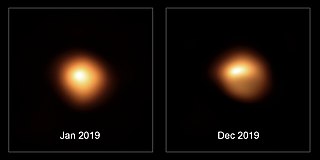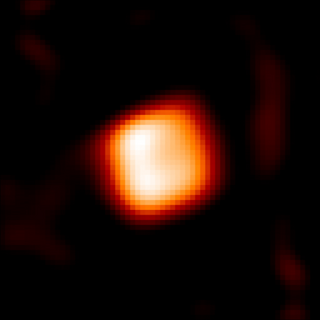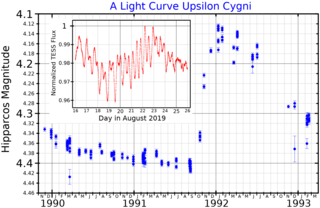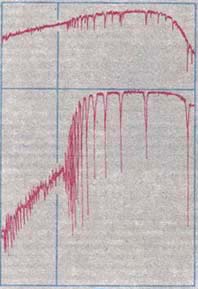
In astronomy, stellar classification is the classification of stars based on their spectral characteristics. Electromagnetic radiation from the star is analyzed by splitting it with a prism or diffraction grating into a spectrum exhibiting the rainbow of colors interspersed with spectral lines. Each line indicates a particular chemical element or molecule, with the line strength indicating the abundance of that element. The strengths of the different spectral lines vary mainly due to the temperature of the photosphere, although in some cases there are true abundance differences. The spectral class of a star is a short code primarily summarizing the ionization state, giving an objective measure of the photosphere's temperature.

A variable star is a star whose brightness as seen from Earth changes with time. This variation may be caused by a change in emitted light or by something partly blocking the light, so variable stars are classified as either:

A blue supergiant (BSG) is a hot, luminous star, often referred to as an OB supergiant. They have luminosity class I and spectral class B9 or earlier.

A B-type main-sequence star is a main-sequence (hydrogen-burning) star of spectral type B and luminosity class V. These stars have from 2 to 16 times the mass of the Sun and surface temperatures between 10,000 and 30,000 K. B-type stars are extremely luminous and blue. Their spectra have strong neutral helium absorption lines, which are most prominent at the B2 subclass, and moderately strong hydrogen lines. Examples include Regulus and Algol A.
A Gamma Cassiopeiae variable is a type of variable star, named for its prototype γ Cassiopeiae.

Omega Canis Majoris, Latinized from ω Canis Majoris, is a solitary, blue-white-hued star in the equatorial constellation of Canis Major. It is visible to the naked eye with an apparent visual magnitude of about 4. Based upon an annual parallax shift of just 3.58 mas as seen from Earth, this system is located roughly 910 light-years from the Sun.

Gamma Cassiopeiae, Latinized from γ Cassiopeiae, is a bright star at the center of the distinctive "W" asterism in the northern circumpolar constellation of Cassiopeia. Although it is a fairly bright star with an apparent visual magnitude that varies from 1.6 to 3.0, it has no traditional Arabic or Latin name. It sometimes goes by the informal name Navi. It was observed 1866 by Angelo Secchi, the first star ever observed with emission lines. It is now considered a Be star.

VV Cephei, also known as HD 208816, is an eclipsing binary star system located in the constellation Cepheus, approximately 5,000 light years from Earth. It is both a B[e] star and shell star.

A yellow hypergiant (YHG) is a massive star with an extended atmosphere, a spectral class from A to K, and, starting with an initial mass of about 20–60 solar masses, has lost as much as half that mass. They are amongst the most visually luminous stars, with absolute magnitude (MV) around −9, but also one of the rarest, with just 20 known in the Milky Way and six of those in just a single cluster. They are sometimes referred to as cool hypergiants in comparison with O- and B-type stars, and sometimes as warm hypergiants in comparison with red supergiants.

HR Carinae is a luminous blue variable star located in the constellation Carina. It is surrounded by a vast nebula of ejected nuclear-processed material because this star has a multiple shell expanding atmosphere. This star is among the most luminous stars in the Milky Way. It has very broad emission wings on the Balmer lines, reminiscent from the broad lines observed in the spectra of O and Wolf–Rayet stars. A distance of 5 kpc and a bolometric magnitude of -9.4 put HR Car among the most luminous stars of the galaxy.

RW Cephei is a K-type hypergiant variable star in the constellation Cepheus, at the edge of the Sharpless 132 H II region and close to the small open cluster Berkeley 94. It is among the largest stars known with a radius of almost 1,000 times that of the Sun (R☉), nearly as large as the orbit of Jupiter.

A shell star is a star having a spectrum that shows extremely broad absorption lines, plus some very narrow absorption lines. They typically also show some emission lines, usually from the Balmer series but occasionally of other lines. The broad absorption lines are due to rapid rotation of the photosphere, the emission lines from an equatorial disk, and the narrow absorption lines are produced when the disc is seen nearly edge-on.

A hypergiant (luminosity class 0 or Ia+) is a very rare type of star that has an extremely high luminosity, mass, size and mass loss because of its extreme stellar winds. The term hypergiant is defined as luminosity class 0 (zero) in the MKK system. However, this is rarely seen in literature or in published spectral classifications, except for specific well-defined groups such as the yellow hypergiants, RSG (red supergiants), or blue B(e) supergiants with emission spectra. More commonly, hypergiants are classed as Ia-0 or Ia+, but red supergiants are rarely assigned these spectral classifications. Astronomers are interested in these stars because they relate to understanding stellar evolution, especially star formation, stability, and their expected demise as supernovae.

Upsilon Cygni, Latinized from υ Cygni, is a star in the northern constellation of Cygnus. It is visible to the naked eye, having an apparent visual magnitude of 4.43. Based upon an annual parallax shift of 5.0 mas, it lies at a distance of roughly 650 light years from the Sun.

28 Cygni is a binary star in the northern constellation of Cygnus. It is a faint blue-white hued star but visible to the naked eye with an apparent visual magnitude of 4.93. The distance to 28 Cyg, as estimated from its annual parallax shift of 5.3 mas, is around 620 light years. It has an absolute magnitude of −2.56, which means that if the star were just 10 parsecs away it would be brighter than Sirius, the brightest star in the night sky.

48 Librae is a single shell star in the constellation Libra. It is a variable star with the designation FX Lib, ranging in magnitude from 4.74 to 4.96. Based upon an annual parallax shift of 6.97±0.24 mas as seen from Earth's orbit, it is located around 470 light years from the Sun. It is a candidate member of the Upper Scorpius group of the Scorpius–Centaurus association, with the former having an age of about 11 million years.

AE Andromedae is a luminous blue variable (LBV), a type of variable star. The star is one of the most luminous variables in M31, the Andromeda Galaxy.
64 Serpentis is a single, blue-white hued star in Serpens Cauda, the eastern segment of the equatorial constellation of Serpens. With an apparent visual magnitude of 5.56, it is a dim star but visible to the naked eye in good seeing conditions. Based upon an annual parallax shift of 2.87±0.26 mas, it is located roughly 1,100 light years away. It is moving closer to the Sun with a heliocentric radial velocity of about −10 km/s. It is one of the brightest stars in front of the Great Rift.

HR 6819, also known as HD 167128 or QV Telescopii, is a double star system in the southern constellation of Telescopium. It is in the south-western corner of the constellation, near Pavo to the south and Ara to the west. The system appears as a variable star that is dimly visible to the naked eye with an apparent magnitude that ranges from 5.32 down to 5.39, which is comparable to the maximum brightness of the planet Uranus. It is about 1,120 light years from the Sun, and is drifting farther away at a rate of 9.4 km/s. Due to its location in the sky, it is visible only to observers south of 33°N latitude.

The Balmer jump, Balmer discontinuity, or Balmer break is the difference of intensity of the stellar continuum spectrum on either side of the limit of the Balmer series of hydrogen, at approximately 364.5 nm. It is caused by electrons being completely ionized directly from the second energy level of a hydrogen atom, which creates a continuum absorption at wavelengths shorter than 364.5 nm.

















